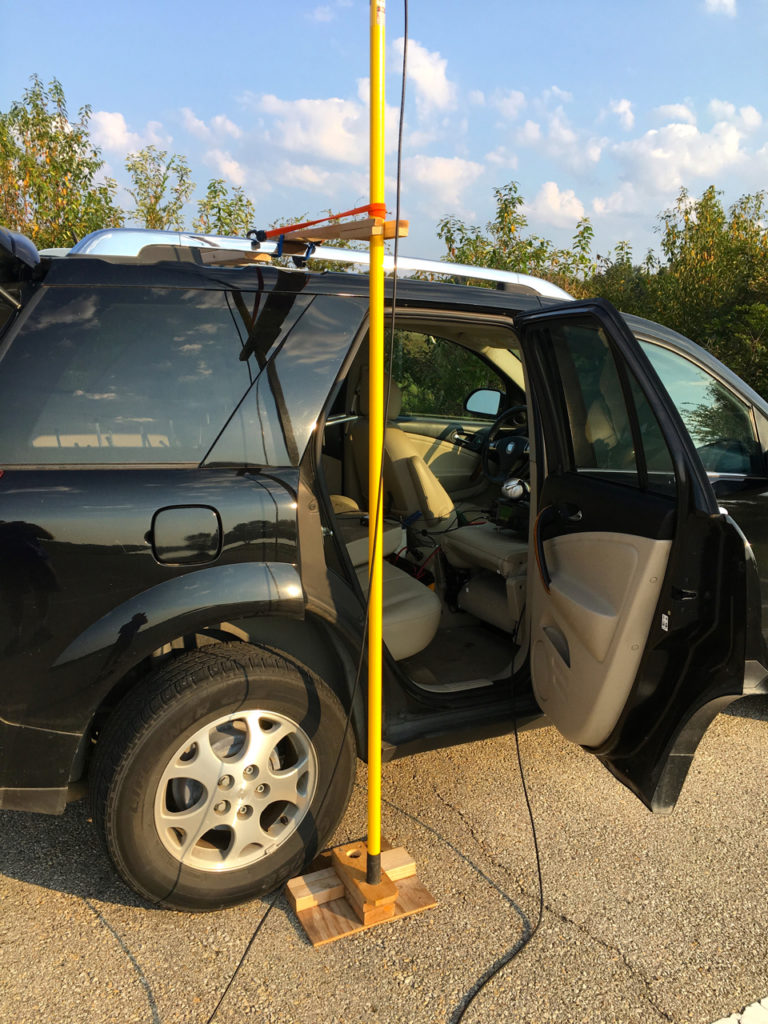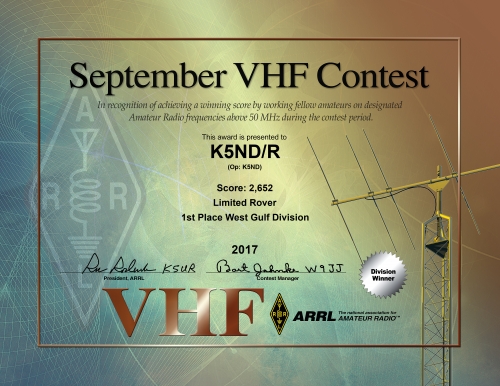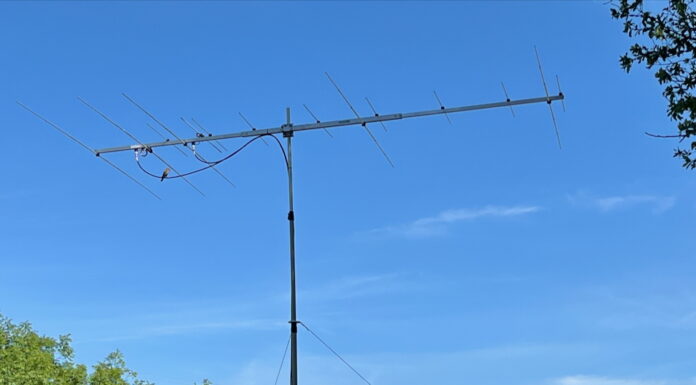Overall Results
 I activated 8 grids: EM01, EM02, EM03, EM11, EM12, EM13, EM22, and EM23. I typically worked many of the same stations from each grid for a total contact count of 78 and worked grid count of 20. With the extra rover grid multipliers my score came in at 3,024.
I activated 8 grids: EM01, EM02, EM03, EM11, EM12, EM13, EM22, and EM23. I typically worked many of the same stations from each grid for a total contact count of 78 and worked grid count of 20. With the extra rover grid multipliers my score came in at 3,024.
Equipment Setup
I only operated 2 meters and 70 centimeters using my IC-910H. I didn’t feel six meters was needed in September, or January. In June I’ll stay home and work six meters.
I used a 5-element Diamond yagi on 2 meters and 15-element Diamond yagi on 70 centimeters. I used a painter pole for the mast at about 18 feet. You can see the brackets I built to attach it to the car.
The painter pole worked pretty well. However, I feel that the 15-element yagi was too big for it. Next time, I’ll use the 10-element version that is currently on my home mast, swapping them out. Since the wind was light, I didn’t struggle with keeping the thing from whipping around. Probably need some sort of guy line next time.
The pole was perfectly positioned by the rear passenger door. That allowed me to sit down, operate the radio which was sitting on the folded over front passenger seat and use the computer on the folded over rear passenger seat. Plus, I could reach out the door and turn the mast to point the antennas. Not the best ergonomics, but it worked.
Travel Route
The travel route worked well. I had scouted out the sites for both the Saturday and Sunday route over the past few weeks. I planned the route to optimize making QSOs into the Dallas-Fort Worth area. But I found that most of the stations on the air were south near Austin. So my thinking there needs to be adjusted.
The Saturday route was EM22, EM12, EM23, and EM13. Sunday covered EM03, EM02, EM01, and EM11. Total distance traveled was just under 600 miles and took roughly 10 hours of driving.
Grid Locations
I found a couple of my locations weren’t the best. In EM23, I set up at Cooper Lake State Park. But the path to the south wasn’t that great and at exactly 6 PM the nearby building lit up and generated a great deal of noise. Won’t go back there.
Based on that experience, I made an adjustment to my Sunday morning EM03 location. I had been planning to activate a roadside picnic area but it was not at the highest point. Instead, I found a perfect spot, high on a ridge, getting on the air just as the sun was rising. Check out the photo.
I may need to revisit my choice for EM22 and EM12. They are both within Purtis Creek State Park. EM22 seemed to work, but EM12 didn’t get very many responses. So perhaps I just need to choose another location for EM12. The others, save for EM23 noted above, worked well. I probably just need to revisit my Saturday routing. Sunday worked perfectly
Logging
Skookum Logger worked just fine for this application. While it’s not set up specifically for rover operations, it does allow entering different grids for sending as well as designating stations as rovers. The latter allows you to work them several times without getting a “duplicate” warning. It also has location services, which I need to investigate further.
My one challenge was determining where to point my antennas to call CQ or to work a schedule. I had the iPhone compass and I could look up the grid-to-grid bearing on the iPhone. But the screen was really cramped for the latter. I probably should activate a personal hotspot on the phone and use the laptop to activate the Internet queries. More work on that one.
Power
For power I have a small 12 volt battery that is also connected to the car’s power system. My thinking is that this puts less stress on the car’s system. I also have a fear that I’ll be so engrossed in making contacts that I’ll run the car’s battery down and won’t be able to start it.
I’m also using a power inverter to run the laptop’s charger. You can tell that I don’t trust batteries. I like to keep them fully charged whenever possible.
Thanks
Thank you to everyone who watched for me to open up in a new grid. Also to K5QE who accepted my phone calls and pointed their antenna toward me in each grid. They also managed to dig out my signal on 432 in most of the grids. W5ZG also dug out my signal on CW. While K5LLL and WA5LFD found me right away on most grids.
Thanks also to all my satellite buddies who go rovering all the time, across continents. They gave me insight into the joys of rovering as well as the joy of working a new grid thanks to their efforts.
I hope I was able to make a difference in a few contest scores in addition to the fun I had working so many stations from several different locations.
The results are in. K5ND/R managed to come in 3rd in the Midwest Region and 1st in the West Gulf Division in the Limited Rover Category. Not bad for a first effort. See this link for the full results 2017 ARRL September VHF Contest. BTW — the photo at the top of this blog post also made it into the full results article and the QST article, April 2018 issue, as well as the August 2018 issue in the preview for the 2018 September contest.









